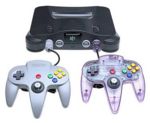Nintendo 64

| |

| |
| Nintendo 64 | |
| Manufacturer | Nintendo |
| Type | Home Console |
| Generation | Fifth |
| Lifespan | 1996 - 2002 |
| CPU | 93.75 MHz NEC VR4300 |
| GPU | 62.5 MHz SGI RCP |
| Media | Cartridge |
| Storage | Cartridge battery, Controller Pak |
| Controllers | Four inputs |
| Online Service | RANDnetDD (Japan only) |
| Release Date | JP June 23, 1996 NA September 29, 1996 EU March 1, 1997 FR September 1, 1997 |
| Units Sold | 32.93 million |
| Top Game | Super Mario 64 |
| Predecessor | Super Nintendo |
| Successor | Nintendo GameCube |
The Nintendo 64 is Nintendo's third console sold internationally. It's named for it's 64-bit processor. In America, it had two launch titles: Super Mario 64 and Pilotwings 64. In Japan, it had the same two games as well as Saikyō Habu Shōgi.
History[edit]
Development[edit]
The Nintendo 64 is a joint effort between Nintendo, Silicon Graphics, and MIPS Technologies. The SGI-system that the Nintendo 64 is based on was originally offered to SEGA of America. Ultimately, SEGA turned it down due to internal problems.
In the early stages, the Nintendo 64 was referred to as "Project Reality." At 1995's 7th Annual Shoshinkai Software Exhibition, the system was unveiled as the Nintendo Ultra 64.
During development, Rareware and Midway claimed that their arcade games Killer Instinct and Cruis'n USA were built on the Nintendo 64's hardware. This wasn't true.
In February 1, 1996, Nintendo was forced to drop the "Ultra" name due to copyright issues with Ultra Games, a company owned by Konami.
Launch[edit]
The Nintendo 64 was released in Japan in June 23, 1996; in America and Brazil in September 29, 1996; in Europe and Australia in March 1, 1997; and in France in September 1, 1997.
The Nintendo 64, lacking third party support due to the decision to support cartridges, didn't sell as well as the Sony Playstation in any region. It did manage to outsell the SEGA Saturn.
Designs[edit]
Nintendo 64[edit]
Looking about the same in all regions, the Nintendo 64 is a roughly rectangular console with a round bump in the middle. Near the front is a slot where the player can put the expansion pack required for certain games. The controller is an odd shape with three handles.
iQue[edit]
Designed by iQue, it's known in China as Shen You Ji(literally "Holy Playing Machine"). The system is contained entirely in the controller and plugs straight into the TV. Currently, it's only available in China due to piracy issues.
Games are stored on a 64 MB memory card which can be downloaded at iQue depots. Currently, 14 games are available for the iQue and all of them are Nintendo titles.
See Also[edit]
Accessories:
| Nintendo Systems |
|---|
| NES - Super NES - Nintendo 64 - GameCube - Wii - Wii U - Switch Game Boy - Game Boy Color - Game Boy Advance - Nintendo DS (DSi) - 3DS (New 3DS) Arcade - Color TV Game - Game & Watch - Virtual Boy |